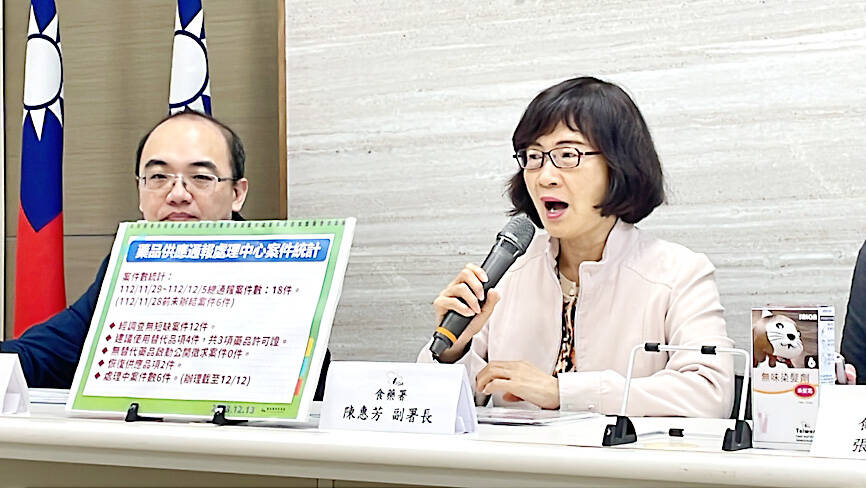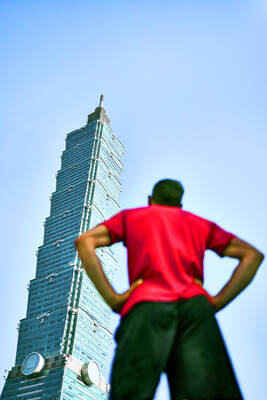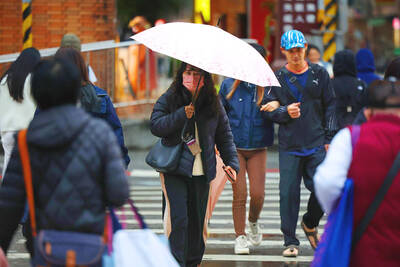The Food and Drug Administration (FDA) yesterday urged people to only buy hair dye products approved by the agency and to follow instructions carefully to avoid irritating the scalp or causing an allergic reaction.
Sometimes people who have never dyed their hair before do not perform a test application and haphazardly apply the product directly to their hair and scalp, with it dripping on their neck and ears, which causes redness and irritation, and could lead to skin infection due to scratching, FDA Deputy Director Cheng Hwei-fang (陳惠芳) said.
Skin irritation and allergic reactions could be avoided by purchasing FDA-approved hair dye products and following the instructions, Cheng said.

Photo: CNA
Hair dye products are categorized as “specific purpose cosmetics,” FDA Medical Devices and Cosmetics Division section head Chang Chia-jung (張家榮) said.
While the agency has issued more than 7,000 permits for hair dyes, containing 104 ingredients, including wax, powder and liquid versions, it has not approved any shampoo for coloring and washing hair at the same time, Chang said.
People should avoid mixing hair dye products, which could cause unpredictable chemical reactions, he said.
The FDA recommends following six steps when dyeing hair at home: Choose products with clear labeling; make sure there are no open wounds or abnormal skin conditions on the scalp or surrounding area before applying; carefully follow the instructions and safety tips; brush or smear the dye on the hair instead of massaging it into the scalp; pay attention to the skin condition after coloring the hair; and wait at least three months before dyeing it again, he said.
People should not perm their hair within a week before or after coloring it, as dyeing or perming the hair can damage the hair cuticle, he said, adding that it is better to do the procedures at least seven days apart.
Linkou Chang Gung Memorial Hospital dermatologist Huang Yu-huei (黃毓惠) said that people should apply a small amount of hair dye behind the ear or the bend of the elbow with a cotton swab to see if it causes an allergic reaction before using a hair dye.
An allergic reaction does not always occur immediately, so people should wait about 48 hours to make sure they are not allergic to the chemicals in the product, Huang said.
People who have skin disorders such as seborrheic dermatitis or atopic dermatitis should avoid coloring their hair, she said.
Even people who do not have an allergic reaction to hair dye products should still apply the dye on the hair and not on their scalp, she said.
The misconception that dyeing the hair would cause balding or lead to gray hairs are unfounded, as hair dye does not reach the hair follicle, she said.
The FDA recommends wearing gloves and placing a towel over the neck when coloring hair at home, Chang said, adding that people should report adverse reactions to cosmetics, drugs, food or medical devices on the agency’s product quality management Web site (qms.fda.gov.tw/tcbw).
Additional reporting by Chiu Chih-jou

US climber Alex Honnold is to attempt to scale Taipei 101 without a rope and harness in a live Netflix special on Jan. 24, the streaming platform announced on Wednesday. Accounting for the time difference, the two-hour broadcast of Honnold’s climb, called Skyscraper Live, is to air on Jan. 23 in the US, Netflix said in a statement. Honnold, 40, was the first person ever to free solo climb the 900m El Capitan rock formation in Yosemite National Park — a feat that was recorded and later made into the 2018 documentary film Free Solo. Netflix previewed Skyscraper Live in October, after videos

NUMBERS IMBALANCE: More than 4 million Taiwanese have visited China this year, while only about half a million Chinese have visited here Beijing has yet to respond to Taiwan’s requests for negotiation over matters related to the recovery of cross-strait tourism, the Tourism Administration said yesterday. Taiwan’s tourism authority issued the statement after Chinese-language daily the China Times reported yesterday that the government’s policy of banning group tours to China does not stop Taiwanese from visiting the country. As of October, more than 4.2 million had traveled to China this year, exceeding last year. Beijing estimated the number of Taiwanese tourists in China could reach 4.5 million this year. By contrast, only 500,000 Chinese tourists are expected in Taiwan, the report said. The report

Temperatures are forecast to drop steadily as a continental cold air mass moves across Taiwan, with some areas also likely to see heavy rainfall, the Central Weather Administration (CWA) said. From today through early tomorrow, a cold air mass would keep temperatures low across central and northern Taiwan, and the eastern half of Taiwan proper, with isolated brief showers forecast along Keelung’s north coast, Taipei and New Taipei City’s mountainous areas and eastern Taiwan, it said. Lows of 11°C to 15°C are forecast in central and northern Taiwan, Yilan County, and the outlying Kinmen and Lienchiang (Matsu) counties, and 14°C to 17°C

STEERING FAILURE: The first boat of its class is experiencing teething issues as it readies for acceptance by the navy, according to a recent story about rudder failure The Hai Kun (海鯤), the nation’s first locally built submarine, allegedly suffered a total failure of stern hydraulic systems during the second round of sea acceptance trials on June 26, and sailors were forced to manually operate the X-rudder to turn the submarine and return to port, news Web site Mirror Daily reported yesterday. The report said that tugboats following the Hai Kun assisted the submarine in avoiding collisions with other ships due to the X-rudder malfunctioning. At the time of the report, the submarine had completed its trials and was scheduled to begin diving and surfacing tests in shallow areas. The X-rudder,